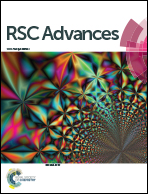The isotopic effects of 13C-labeled large carbon cage (C70) fullerenes and their formation process
Abstract
Fullerene, C60, and its derivatives, have been fully investigated and commercialized. The importance of large carbon cage-based fullerenes for biomedical applications was gradually recognized due to their fantastic biological effects. In nanotoxicology, the key detection techniques are able to retain the intrinsic structure and properties of nanomaterials in a biological background. However, there were puzzling questions regarding how to facilely obtain detectable fullerene nanomaterials and their formation process. In this study, 13C-enriched fullerenes of a large carbon cage, C70, were synthesized on a large scale from a 13C-enriched raw carbon material by an arc-discharge method. The stable isotope 13C was directly incorporated into the skeleton of the fullerene cages without destroying their intrinsic structures. The isotopic effects of 13C-labeled C70 were investigated in detail. The amount of 13C labelling of C70 was about 7% higher than that of the natural abundance, which greatly improved the 13C detection signal in isotope ratio mass spectrometry and gave an apparent 8-fold carbon nuclear magnetic resonance signal enhancement for the fullerenes. The 13C-enriched fullerenes showed significant isotopic effects, such as the strongest peak position shifting up (m/z > 840) and the Poisson distribution of the isotopic peaks in the mass spectra, and the migration or splitting of infrared and Raman characteristic peaks. When comparing the 13C labelling amounts and the isotopic effects of 13C-enriched C70 and those of 13C-enriched C60, the formation dynamics of the fullerenes were different with different carbon cages; lower carbon cage fullerenes were easily generated in the arc-discharge process, and the 13C stable isotopic effects in high carbon fullerenes were also slightly weak. Moreover, these important isotopic effects of the 13C-enriched fullerenes will facilitate the development of new analytical methods for carbon nanomaterials in vivo.



 Please wait while we load your content...
Please wait while we load your content...